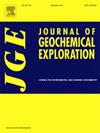Geochemical characteristics and petrogenesis of uranium-bearing and barren granites in the Miao'ershan Batholith, South China: Implications for U mineralization
IF 3.3
2区 地球科学
Q1 GEOCHEMISTRY & GEOPHYSICS
引用次数: 0
Abstract
The Miao'ershan batholith in South China is an important domain for granite-hosted uranium mineralization, comprising both uranium-bearing (Douzhashan) and barren (Yangqiaoling and Xiangcaoping) granites. However, the processes governing uranium enrichment in granitic systems, as well as the factors responsible for the contrasting fertility of these granites remain poorly understood. This study integrates zircon U![]() Pb geochronology, zircon trace element geochemistry, and in situ chemical analysis of both discrete apatite grains and apatite inclusions within zircon to elucidate the petrogenetic processes and physicochemical conditions that distinguish uranium-bearing from barren granite. Zircon U
Pb geochronology, zircon trace element geochemistry, and in situ chemical analysis of both discrete apatite grains and apatite inclusions within zircon to elucidate the petrogenetic processes and physicochemical conditions that distinguish uranium-bearing from barren granite. Zircon U![]() Pb dating constrains the crystallization ages of the Yangqiaoling, Xiangcaoping, and Douzhashan granites to 218.6 ± 1.8 Ma, 223.3 ± 1.9 Ma, and 213.5 ± 1.8 Ma to 212.2 ± 1.6 Ma, respectively. Variations in apatite Cl/F ratios, combined with published whole-rock geochemical data, indicate that the Douzhashan granite is a strongly peraluminous S-type granite derived from the partial melting of meta-sedimentary rocks, whereas the Yangqiaoling granite reflects a mixed magmatic source involving both meta-sedimentary and meta-igneous components, and the Xiangcaoping granite exhibits intermediate characteristics. Apatite trace element compositions reveal that the Douzhashan granite underwent a higher degree of magmatic differentiation than the barren granites, as evidenced by lower concentrations of Sr, Th, and light rare earth elements (LREE), reduced (La/Yb)N and (Sm/Yb)N ratios, and elevated contents Y and Mn. Geochemical proxies from both zircon and apatite, including (Eu/Eu*)N, Ce/Nd, and Y/ΣREE ratios, suggest that all three granites crystallized under low oxygen fugacity conditions. Therefore, uranium enrichment in the Douzhashan granite was driven by a combination of distinct source characteristics, advanced magmatic differentiation and reduced magmatic conditions, which collectively enhanced uranium solubility and retention in the melt. These results provide new insights into the petrogenetic controls on granite-hosted uranium mineralization and establish a geochemical framework for guiding future uranium exploration in similar geological settings.
Pb dating constrains the crystallization ages of the Yangqiaoling, Xiangcaoping, and Douzhashan granites to 218.6 ± 1.8 Ma, 223.3 ± 1.9 Ma, and 213.5 ± 1.8 Ma to 212.2 ± 1.6 Ma, respectively. Variations in apatite Cl/F ratios, combined with published whole-rock geochemical data, indicate that the Douzhashan granite is a strongly peraluminous S-type granite derived from the partial melting of meta-sedimentary rocks, whereas the Yangqiaoling granite reflects a mixed magmatic source involving both meta-sedimentary and meta-igneous components, and the Xiangcaoping granite exhibits intermediate characteristics. Apatite trace element compositions reveal that the Douzhashan granite underwent a higher degree of magmatic differentiation than the barren granites, as evidenced by lower concentrations of Sr, Th, and light rare earth elements (LREE), reduced (La/Yb)N and (Sm/Yb)N ratios, and elevated contents Y and Mn. Geochemical proxies from both zircon and apatite, including (Eu/Eu*)N, Ce/Nd, and Y/ΣREE ratios, suggest that all three granites crystallized under low oxygen fugacity conditions. Therefore, uranium enrichment in the Douzhashan granite was driven by a combination of distinct source characteristics, advanced magmatic differentiation and reduced magmatic conditions, which collectively enhanced uranium solubility and retention in the melt. These results provide new insights into the petrogenetic controls on granite-hosted uranium mineralization and establish a geochemical framework for guiding future uranium exploration in similar geological settings.
苗儿山基含铀和贫铀花岗岩地球化学特征及成因:铀成矿意义
华南苗儿山岩体是花岗岩型铀矿成矿的重要区域,既有含铀花岗岩(斗寨山),也有贫铀花岗岩(杨桥岭和香草坪)。然而,控制花岗岩系统中铀富集的过程,以及负责这些花岗岩的对比肥力的因素仍然知之甚少。结合锆石UPb年代学、锆石微量元素地球化学和锆石中离散磷灰石颗粒和磷灰石包裹体的原位化学分析,阐明了锆石中含铀花岗岩的成岩过程和物化条件。锆石UPb定年限制了杨桥岭、香草坪和斗寨山花岗岩的结晶年龄分别为218.6±1.8 Ma、223.3±1.9 Ma和213.5±1.8 Ma ~ 212.2±1.6 Ma。磷灰石Cl/F比值变化结合已发表的全岩地球化学资料表明,斗寨山花岗岩为变质沉积岩部分熔融形成的强过铝质s型花岗岩,杨桥岭花岗岩为变质沉积岩和变质火成岩混合岩浆源,相草坪花岗岩表现出中间特征。磷灰石微量元素组成表明,斗寨山花岗岩的岩浆分异程度高于秃斑花岗岩,Sr、Th和轻稀土元素(LREE)浓度较低,(La/Yb)N和(Sm/Yb)N比值降低,Y和Mn含量升高。锆石和磷灰石的地球化学指标(Eu/Eu*)N、Ce/Nd和Y/ΣREE比值)表明,三种花岗岩均在低氧逸度条件下结晶。因此,斗寨山花岗岩中铀的富集是由明显的物源特征、超前的岩浆分异和减弱的岩浆条件共同驱动的,这些共同增强了铀在熔体中的溶解度和滞留性。这些结果为认识花岗岩型铀矿化的成因控制提供了新的认识,并为今后类似地质环境下的铀矿找矿建立了地球化学框架。
本文章由计算机程序翻译,如有差异,请以英文原文为准。
求助全文
约1分钟内获得全文
求助全文
来源期刊

Journal of Geochemical Exploration
地学-地球化学与地球物理
CiteScore
7.40
自引率
7.70%
发文量
148
审稿时长
8.1 months
期刊介绍:
Journal of Geochemical Exploration is mostly dedicated to publication of original studies in exploration and environmental geochemistry and related topics.
Contributions considered of prevalent interest for the journal include researches based on the application of innovative methods to:
define the genesis and the evolution of mineral deposits including transfer of elements in large-scale mineralized areas.
analyze complex systems at the boundaries between bio-geochemistry, metal transport and mineral accumulation.
evaluate effects of historical mining activities on the surface environment.
trace pollutant sources and define their fate and transport models in the near-surface and surface environments involving solid, fluid and aerial matrices.
assess and quantify natural and technogenic radioactivity in the environment.
determine geochemical anomalies and set baseline reference values using compositional data analysis, multivariate statistics and geo-spatial analysis.
assess the impacts of anthropogenic contamination on ecosystems and human health at local and regional scale to prioritize and classify risks through deterministic and stochastic approaches.
Papers dedicated to the presentation of newly developed methods in analytical geochemistry to be applied in the field or in laboratory are also within the topics of interest for the journal.
 求助内容:
求助内容: 应助结果提醒方式:
应助结果提醒方式:


